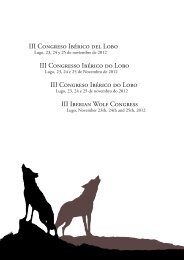Bison-Rewilding-Plan-2014
Bison-Rewilding-Plan-2014
Bison-Rewilding-Plan-2014
- No tags were found...
Create successful ePaper yourself
Turn your PDF publications into a flip-book with our unique Google optimized e-Paper software.
Use of pulka totransport and loadbison in Swedenprotect the eyes from dust etc. During the wholeimmobilisation process, loud noises should beavoided as much as possible. The muzzle shouldalways be directed towards the ground to allowany ingesta to flow out of the mouth and avoidchoking. Individual pads may be placed around themetatarsal areas on each rear leg. Separate ropescan then be tied around each rear leg over the padsand secured to a solid object behind the animal (e.g.a pole or tree). The front legs can be tied togetherand similarly secured in front of the animal. Ifthere is nothing to secure them to, the rear legs canbe tied together to reduce the likelihood of injurydue to kicking.The duration of anaesthesia for bison shouldbe no more than 60 minutes due to the risk ofpressure necrosis. Animals should be observedclosely for evidence of bloat throughout all procedures.Once all necessary procedures have beencompleted, any restraining ropes should beremoved from the animal’s legs and non-essentialpersonnel should leave the area. The immobilisingdrug is then reversed with naltrexone or otherantagonist as appropriate. An animal should be lefton its own while awakening.Animals should be monitored for up to 48 hourspost-immobilisation for signs of renarcotisation. Thisoccurs when the immobilising drug is still present inan animal’s system while the reversal drug is beingcleared to a level where it is no longer effective. Ananimal may exhibit signs similar to those of narcoticinduction, including sedation, pacing, vocalizing,atraxia, head-pressing or even sternal recumbency.If the animal is being transported a long working(up to 10 days) sedative should be administered toreduce stress levels. The animals should be fullyrecovered and standing before the transport ationcan start.It is best to construct the bison infrastructureat the handling zone in such a way that animalscan be loaded into a trailer without tranquilisation.This can be achieved by constructingdivisions and a hallway in which the animals canbe gradually ‘forced’ forward on to the trailer. Theconstruction must be save (for handlers and bison),well constructed.If the bison need to be bison tranquilised a specialtransportation ‘blanket’ or pulka can be used.Use of forklifts and other mechanical equipmentshould be kept to a minimum and be used withgreat care to avoid risks of wounding the animal.56STAFFAN WIDSTRAND / REWILDING EUROPE



